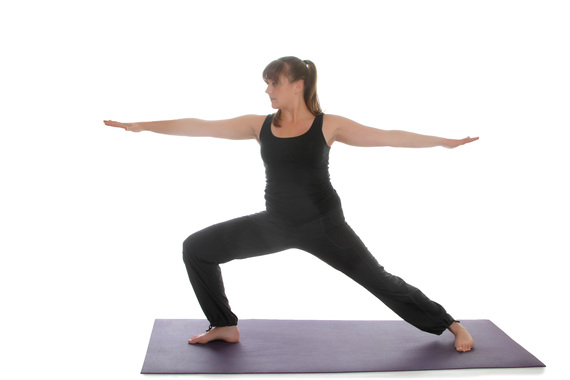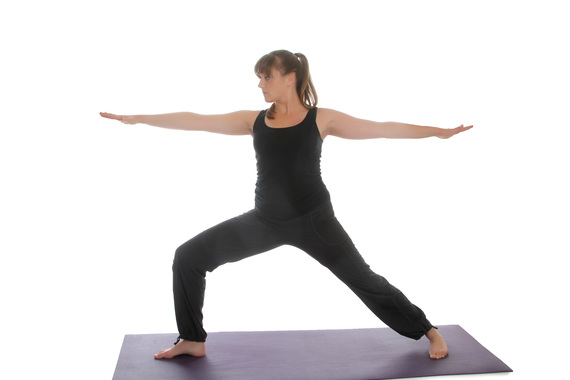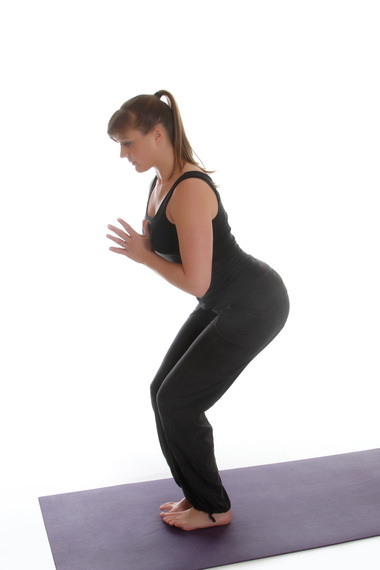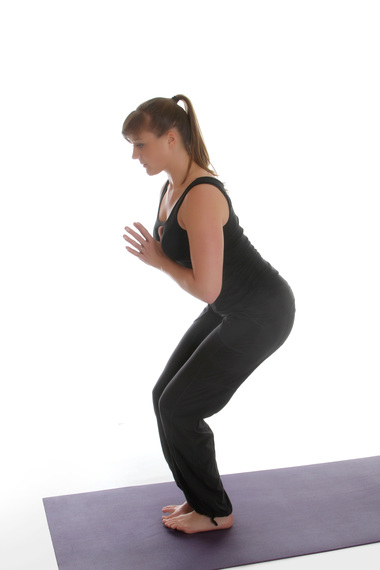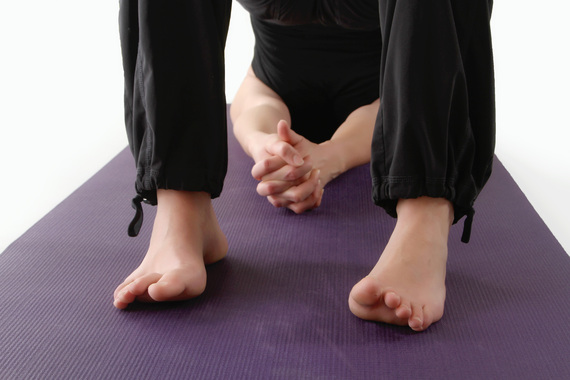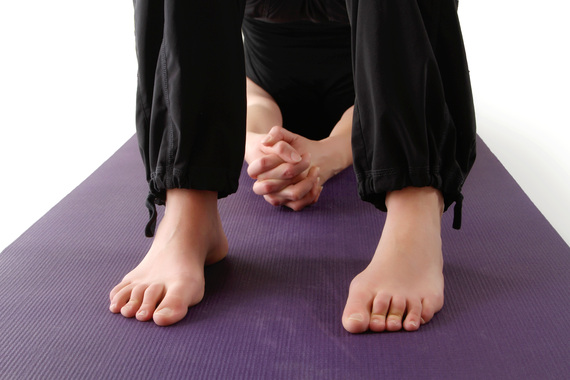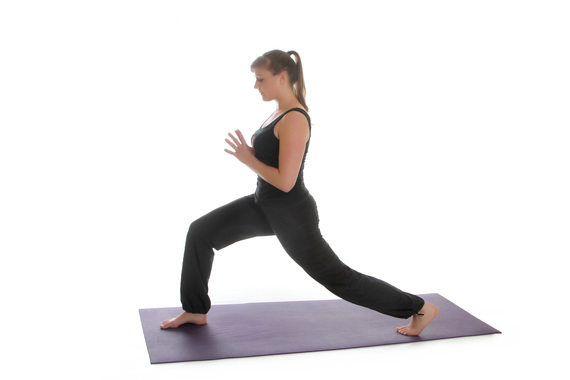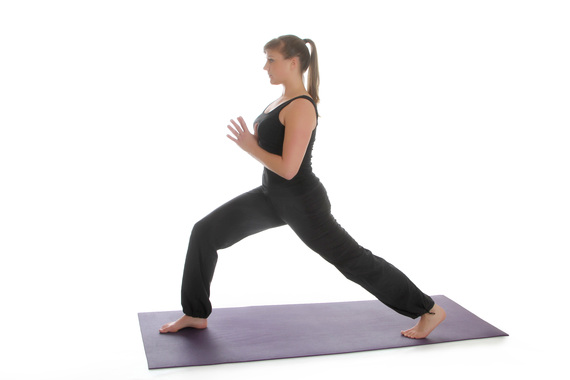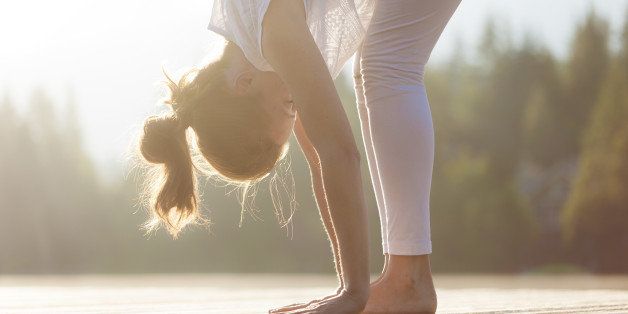
Yoga is all about respecting where your body is currently at and gently pushing its comfort zone. It's certainly not about perfection or looking a certain way in your yoga gear or on your mat.
However, there are certain alignment principles that will keep you safe and will ensure that your time on your mat is actually doing your body good.
When those principles aren't known or being followed, they show up as these mistakes:
Your Knees Are Over Your Toes
Whenever you're in a lunging or squatting posture, you want your knees to stay behind your toes. For example, in Warrior II (pictured below), once your front knee goes past your toes, your joints take on added pressure and the muscles that you want to tone and strengthen, like your thighs, don't have to work as hard. It's a lose-lose situation.
You Can't See Your Big Toe In Warrior II
This one's simple: while in Warrior II (pictured above), if you glance down and can't see your front big toe, your knee is caving in and that's never a good thing. Keep your front knee gently pulling out towards the pinky toe side of your foot to maintain proper alignment.
Your Shoulders Creep Up To Your Ears
It doesn't matter what yoga posture you're in, it's always a good thing to keep your shoulders pulling towards your hips, not to your ears. This not only helps release tension in your upper body, but it also helps fire up your core.
In other words, when your shoulders are up at your ears, it's really hard for your abdominal muscles to support you properly. When you create space between your shoulders and your ears, it's way easier for you to tone and strengthen your midsection.
You Don't Utilize Your Imaginary Monkey Tail
Whenever you hear the word, "bandha" in yoga, that means lock. Uddiyana bandha is your ribcage to pelvic lock. This lock is imperative to keeping yourself safe during a yoga practice. In fact, prior to learning about this lock, I threw out my back multiple times while doing yoga.
So, what is uddiyana bandha?
Think of yourself in Chair Pose (pictured below) with an imaginary monkey tail. Pull that tail through your legs and up towards your head. Notice what happens to your pelvis.
This lock, where your pelvis tucks and your ribcage drops, is one you can find in any pose to keep yourself safe and your abs engaged.
You Distribute the Weight In Your Feet Improperly
This might not seem like a big deal, but it is. Your feet are the foundation of many poses in yoga. If weight is distributed improperly in your foundation, that affects your entire body.
In single leg balance postures and bridges, I have the tendency to roll my body weight to the pinky toe sides of my feet. To compensate, I have to consciously make sure the big toe sides of my feet are planted.
Among other thing, this will help keep your inner thighs engaged which helps fire up your abdominal muscles and protects your lower back. Keeping the big toe sides of your feet planted in these poses will also strengthen the arches of your feet.
When I'm in Warrior I or Warrior II, however, I have the tendency to roll my body weight to the big toe side of my back foot. To compensate in those poses, I have to consciously push through the pinky toe side of my foot in order to properly distribute my weight and to effectively lengthen and engage my back leg, as intended.
You Sink Into Your Joints
Regardless of the yoga posture, you want your muscles to hold you, not your joints. When you sink into a pose without the engagement of your muscles, you're missing out on a lot of the benefits the pose has to offer.
Crescent Lunge (pictured below) is a great example. If you're not pushing through your back heal in this pose, you're not engaging your back leg properly. This will result in more pressure on your joints and less toning and strengthening.
You Practice the Same Every Time
Yoga is intended to be a workout that meets you where you're at. It's not intended to look or feel the same every time you step on to your mat. Among other things, sleep, nutrition, and stress have a huge impact on how your body functions, day-to-day. Yoga does not encourage you to ignore this varied state of being, but to respect it.
I encourage you to ask these questions at the onset of each practice: What did I bring to the mat today? What am I working with, body-wise and mind-wise? What do I need? What do I need to let go of?
Let these questions guide your practice, instead of letting the person next to you in class or your past "performance" deceptively influence what you think you should be doing.
My mantra: don't assume, experiment.
Just because you did something one day, doesn't mean it's right for you body the next day. Just because you could do it, doesn't mean you should. Give yourself permission to experiment with what works best for you, day-to-day.
